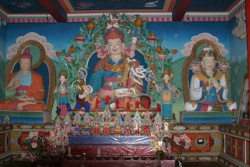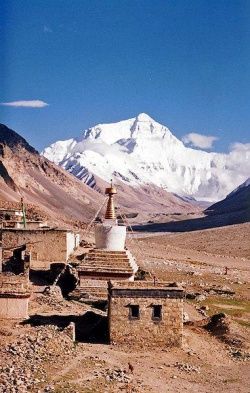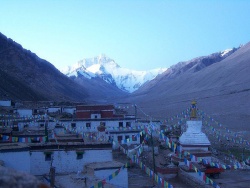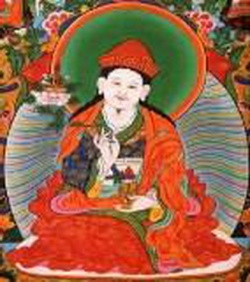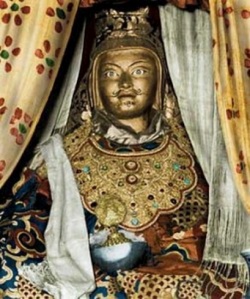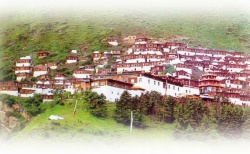Difference between revisions of "The Limitless Vehicles Of The Buddha"
m (Adminos moved page THE LIMITLESS VEHICLES OF THE BUDDHA to The Limitless Vehicles Of The Buddha without leaving a redirect) |
|||
| Line 1: | Line 1: | ||
[[File:445454 guru.JPG|thumb|250px|]] | [[File:445454 guru.JPG|thumb|250px|]] | ||
<poem> | <poem> | ||
| − | The LIMITLESS VEHICLES OF THE BUDDHA present the Dharma in many different ways, all of which are beyond concept. Therefore, it is difficult to find the power or ability to express these. Nevertheless, briefly and with a few words, I shall attempt to explain some of the differences here. The All-Knowing Guide, Lion of the Sakya clan, turned the Wheel of the Dharma on three successive occasions. The first turning taught the elimination of non-virtue 2, the middle taught the elimination of the view of self-identities and the last, the elimination of all grounds for views 3. The subjects of these teachings are the Three Trainings 4, and the words explaining these are found in the Sacred Writings (Sanskrit: Pitaka) 5, where they are gathered into Twelve Scriptural Categories 6. Some people have said that the Tantra of the Mahayana should be classified as an inner Abhidharma teaching. | + | The LIMITLESS VEHICLES OF THE [[BUDDHA]] {{Wiki|present}} the [[Dharma]] in many different ways, all of which are beyond {{Wiki|concept}}. Therefore, it is difficult to find the power or ability to express these. Nevertheless, briefly and with a few words, I shall attempt to explain some of the differences here. The All-Knowing [[Guide]], [[Lion]] of the [[Sakya clan]], turned the [[Wheel of the Dharma]] on three successive occasions. The first turning [[taught]] the elimination of [[non-virtue]] 2, the middle [[taught]] the elimination of the view of self-identities and the last, the elimination of all grounds for [[views]] 3. The [[subjects]] of these teachings are the [[Three Trainings]] 4, and the words explaining these are found in the [[Sacred]] Writings ([[Sanskrit]]: [[Pitaka]]) 5, where they are [[gathered]] into Twelve [[Scriptural]] Categories 6. Some [[people]] have said that the [[Tantra]] of the [[Mahayana]] should be classified as an inner [[Abhidharma]] [[teaching]]. |
| − | However, it has been taught that it is good to classify the Sacred Writings for Tantric Yogis 7 separately, in a section of their own. We find barely more than one hundred volumes of the Buddha's Teachings 8 translated into Tibetan. But actually, there is no power which could capture the infinite significance of the Buddha's speech. There are a great many Commentaries 9 explaining the meanings of these teachings of the Buddha. In the Hinayana, we find the "Mahavibhasa Sastra" and many others; in the Mahayana, such Scholars and Pandits as the Six Ornaments of this earth 10 and the Extraordinary Master etc., all of whom composed a large number of explanations. There is also a great quantity of sadhanas and commentaries to all the Sacred Writings of Secret Tantra. All the important advice which exists is beyond the mind's estimation. But due to the great kindness of these ancient translators and Pandits, more than two hundred volumes of such commentaries have been translated into Tibetan. It is these texts (of the Kangyur and Tangyur) which form the foundation for Buddhism in Tibet. | + | However, it has been [[taught]] that it is good to classify the [[Sacred]] Writings for [[Tantric]] [[Yogis]] 7 separately, in a section of their [[own]]. We find barely more than one hundred volumes of the [[Buddha's Teachings]] 8 translated into [[Tibetan]]. But actually, there is no power which could capture the [[infinite]] significance of the [[Buddha's]] [[speech]]. There are a great many Commentaries 9 explaining the meanings of these [[teachings of the Buddha]]. In the [[Hinayana]], we find the "[[Mahavibhasa]] [[Sastra]]" and many others; in the [[Mahayana]], such [[Scholars]] and [[Pandits]] as the [[Six Ornaments]] of this [[earth]] 10 and the [[Extraordinary]] [[Master]] etc., all of whom composed a large number of explanations. There is also a great {{Wiki|quantity}} of [[sadhanas]] and commentaries to all the [[Sacred]] Writings of Secret [[Tantra]]. All the important advice which [[exists]] is beyond the [[mind's]] estimation. But due to the great [[kindness]] of these [[ancient]] [[translators]] and [[Pandits]], more than two hundred volumes of such commentaries have been translated into [[Tibetan]]. It is these texts (of the [[Kangyur]] and [[Tangyur]]) which [[form]] the foundation for [[Buddhism]] in [[Tibet]]. |
[[File:381px-Mount Everest from Rombok Gompa, Tibet.jpg|thumb|250px|]] | [[File:381px-Mount Everest from Rombok Gompa, Tibet.jpg|thumb|250px|]] | ||
| − | In India, the land of the Noble Beings 11, there was never any division of Buddhism into old and new. In Tibet, however, as some translations occurred earlier and some later, we find such a division. Any translations which came before the time of Rinchen Zangpo (958-1055 A.D.) came to be called rNying.ma or 'old ones', and texts translated by Rinchen Zangpo and the majority of translations which followed, came to be called gSar.ma or 'new ones'. Almost all of the texts of the Vinaya, Sutra, Abhidharma and of the Secret Tantra's three outer Tantras (Kriya, Carya and Yoga) were translated into Tibetan during the early flourishing of Buddhism in Tibet 12, (in the 'old' translation period). The majority of the texts of Highest Yoga Tantra, such as Chakrasamvara, Hevajra, Kalachakra, Yamantaka etc. were 'new' translations, although a great quantity of translations of Highest Yoga Tantra texts wer also prepared during the 'old' translation period. Some scholars of the 'new' period say that these 'old' translations are invalid Tantras. But those who are non-sectarian and non-partisan praise these old translations for their authenticity, and I think their conclusion is in accordance with the actual facts because these translations convey exactly the profound and vast meaning of the Buddha's Teachings and their Commentaries. Therefore, they may be placed upon the crown of your head and respected. | + | In [[India]], the land of the [[Noble Beings]] 11, there was never any [[division]] of [[Buddhism]] into old and new. In [[Tibet]], however, as some translations occurred earlier and some later, we find such a [[division]]. Any translations which came before the [[time]] of [[Rinchen Zangpo]] (958-1055 A.D.) came to be called [[rNying.ma]] or 'old ones', and texts translated by [[Rinchen Zangpo]] and the majority of translations which followed, came to be called gSar.ma or 'new ones'. Almost all of the texts of the [[Vinaya]], [[Sutra]], [[Abhidharma]] and of the Secret [[Tantra's]] [[three outer Tantras]] ([[Kriya]], [[Carya]] and [[Yoga]]) were translated into [[Tibetan]] during the early flourishing of [[Buddhism]] in [[Tibet]] 12, (in the 'old' translation period). The majority of the texts of [[Highest Yoga Tantra]], such as [[Chakrasamvara]], [[Hevajra]], [[Kalachakra]], [[Yamantaka]] etc. were 'new' translations, although a great {{Wiki|quantity}} of translations of [[Highest Yoga Tantra]] texts wer also prepared during the 'old' translation period. Some [[scholars]] of the 'new' period say that these 'old' translations are invalid [[Tantras]]. But those who are [[non-sectarian]] and [[non-partisan]] praise these old translations for their authenticity, and I think their conclusion is in accordance with the actual facts because these translations convey exactly the profound and vast meaning of the [[Buddha's Teachings]] and their Commentaries. Therefore, they may be placed upon the {{Wiki|crown}} of your head and respected. |
THE NYINGMA TRADITION | THE NYINGMA TRADITION | ||
| − | The NYINGMA TRADITION, the old Secret Tantra, classifies the Buddha's Dharma into nine successive Vehicles, collectively contained in the Cause Vehicle 13 and the Result Vehicle 14 of Tantra. The Cause Vehicle has three divisions: the Hinayana Vehicle of the Sravakas, the Hinayana Vehicle of Pratyekabuddhas and the Mahayana Vehicle of the Bodhisattvas. In the Result Vehicle of Tantra there are two divisions: the three Outer Tantric Vehicles, and the three great methods of the Inner Tantric Class 15. | + | The NYINGMA TRADITION, the old Secret [[Tantra]], classifies the [[Buddha's Dharma]] into nine successive Vehicles, collectively contained in the [[Cause]] [[Vehicle]] 13 and the Result [[Vehicle]] 14 of [[Tantra]]. The [[Cause]] [[Vehicle]] has three divisions: the [[Hinayana]] [[Vehicle]] of the [[Sravakas]], the [[Hinayana]] [[Vehicle]] of [[Pratyekabuddhas]] and the [[Mahayana]] [[Vehicle of the Bodhisattvas]]. In the Result [[Vehicle]] of [[Tantra]] there are two divisions: the three Outer [[Tantric]] Vehicles, and the three great methods of the Inner [[Tantric]] Class 15. |
[[File:798px-China107.jpg|thumb|250px|]] | [[File:798px-China107.jpg|thumb|250px|]] | ||
| − | All these have a great many definitions and explanations concerning their view, meditation, action and result, but it is not possible to write these explanations here. There are three lineages in the old translations of the Nyingma Tantras: the 'Distant Oral Lineage' (Tibetan: Ring.rGyud.bKah.ma - from the direct oral teachings of the Buddha); the 'Near Treasure Lineage' (Tib: Nye.rGud.gTer.ma - from teachings of discovered treasure texts, written and concealed in holy places by Guru Rinpoche, Khandro Yeshe Tsogyal and others; for the benefit of future generations), and the 'Lineage of Profound Pure Visions' (Tib: Zab.mo.dag.sNang - from teachings received by various Saints during visions in meditation and post-meditation). | + | All these have a great many definitions and explanations concerning their view, [[meditation]], [[action]] and result, but it is not possible to write these explanations here. There are three [[lineages]] in the old translations of the [[Nyingma]] [[Tantras]]: the '[[Distant Oral Lineage]]' ([[Tibetan]]: Ring.rGyud.bKah.ma - from the [[direct oral teachings of the Buddha]]); the '[[Near Treasure Lineage]]' (Tib: Nye.rGud.gTer.ma - from teachings of discovered [[treasure texts]], written and concealed in {{Wiki|holy}} places by [[Guru Rinpoche]], [[Khandro Yeshe Tsogyal]] and others; for the [[benefit]] of {{Wiki|future}} generations), and the '[[Lineage of Profound Pure Visions]]' (Tib: Zab.mo.dag.sNang - from teachings received by various [[Saints]] during [[visions]] in [[meditation]] and [[post-meditation]]). |
THE KADAM TRADITION | THE KADAM TRADITION | ||
| − | The SARMA Tradition of new translations of the Tantras is also called the Jowo KADAM TRADITION. This Tradition had innumerable Dharma holders. These include Atisha, Gyalwa Dromtonba, the Three Brothers, etc. The old Kadampa | + | The SARMA [[Tradition]] of [[new translations]] of the [[Tantras]] is also called the [[Jowo]] KADAM TRADITION. This [[Tradition]] had {{Wiki|innumerable}} [[Dharma]] holders. These include [[Atisha]], [[Gyalwa]] Dromtonba, the [[Three Brothers]], etc. The old [[Kadampa]] |
| − | spread into the Sakya and Kagyud Lineages. | + | spread into the [[Sakya]] and [[Kagyud]] [[Lineages]]. |
| − | THE GELUG TRADITION | + | THE [[GELUG]] TRADITION |
| − | Manjushri Tzong Kapa (founder of the GELUG TRADITION), sometimes called the new Kadampa) firmly established himself in the old Kadampa and propagated the teachings of the Vinaya, Sutra, Madhyamika, Prajnaparamita, Secret Tantra, etc. His vast Tradition came to cover the entire earth. He explained his view of the meanings of the Sutras and Tantras with the aid of his special Deity and his own analytical wisdom, which came from the treasure chest of very deep wisdom. Many of the unique qualities of his teachings can be clearly seen in his excellent explanations. | + | [[Manjushri]] Tzong Kapa (founder of the [[GELUG]] TRADITION), sometimes called the new [[Kadampa]]) firmly established himself in the old [[Kadampa]] and propagated the teachings of the [[Vinaya]], [[Sutra]], [[Madhyamika]], [[Prajnaparamita]], Secret [[Tantra]], etc. His vast [[Tradition]] came to cover the entire [[earth]]. He explained his view of the meanings of the [[Sutras]] and [[Tantras]] with the aid of his special [[Deity]] and his [[own]] analytical [[wisdom]], which came from the [[treasure]] {{Wiki|chest}} of very deep [[wisdom]]. Many of the unique qualities of his teachings can be clearly seen in his {{Wiki|excellent}} explanations. |
[[File:Chogyur Lingpa.jpg|thumb|250px|]] | [[File:Chogyur Lingpa.jpg|thumb|250px|]] | ||
| − | THE SAKYA TRADITION | + | THE [[SAKYA]] TRADITION |
| − | The SAKYA TRADITION was established by the Five Great Masters (Tib: rJe.tzun.gong.ma.lnga), 16 who based their teachings on those of the conquering Yogi, the Great Virupa. They also followed the teachings of Naropa and Dorje Denpa etc. and held the Sutra and Tantra lineages of many other great Indian scholars and Saints. The Sakya Tradition also came to practise some of the Nyingma 'old' translations of the Tantras, such as Yang.dag.phur.ba (Pure Dagger), which became part of the Khon Tradition. | + | The [[SAKYA]] TRADITION was established by the Five Great [[Masters]] (Tib: rJe.tzun.gong.ma.lnga), 16 who based their teachings on those of the conquering [[Yogi]], the Great [[Virupa]]. They also followed the teachings of [[Naropa]] and [[Dorje Denpa]] etc. and held the [[Sutra]] and [[Tantra]] [[lineages]] of many other great [[Indian]] [[scholars]] and [[Saints]]. The [[Sakya Tradition]] also came to practise some of the [[Nyingma]] 'old' translations of the [[Tantras]], such as Yang.dag.phur.ba ([[Pure]] [[Dagger]]), which became part of the [[Khon Tradition]]. |
| − | Similarly, many other extraordinary and sublime teachings still exist today, their lineages unbroken. Sakya Pandita, the crown ornament of all the Learned Ones of this earth, is famous for having defeated Trogje Gawo (the non-Buddhist Indian scholar) in debate. Except for this outstanding example, no other masters are known for having done likewise at that time. There are three Traditions holding the lineage of Sakya Pandita: the Sakya, the Ngor and the Tshar. From the root of the Sakya Tradition came the three renowned lineages of Bulug, Jonang and Bodong. From all these, a few minor differences in their views of the Sutras and Tantras have emerged from their explanations. | + | Similarly, many other [[extraordinary]] and [[sublime]] teachings still [[exist]] today, their [[lineages]] unbroken. [[Sakya Pandita]], the {{Wiki|crown}} ornament of all the Learned Ones of this [[earth]], is famous for having defeated Trogje Gawo (the [[non-Buddhist]] [[Indian]] [[scholar]]) in [[debate]]. Except for this outstanding example, no other [[masters]] are known for having done likewise at that [[time]]. There are three [[Traditions]] holding the [[lineage]] of [[Sakya Pandita]]: the [[Sakya]], the [[Ngor]] and the [[Tshar]]. From the [[root]] of the [[Sakya Tradition]] came the three renowned [[lineages]] of [[Bulug]], [[Jonang]] and [[Bodong]]. From all these, a few minor differences in their [[views]] of the [[Sutras]] and [[Tantras]] have emerged from their explanations. |
THE KAGYUD TRADITION | THE KAGYUD TRADITION | ||
| − | The KAGYUD TRADITION developed from the teachings of Naropa and Maitrepa. The main founders of all the sects of the Kagyud are the three Great Masters: Marpa, Milarepa and Gampopa. From these three Masters the Kagyud Lineage scattered into the four major 17 and eight minor 18 Lineages. It was from Gampopa's disciple, Phagmo Drupa that most of these lineages of the Kagyud Tradition came, spreading in many different directions 19. Presently there are four which have not faded and still exist: the Karma Kagyud, Drukpa Kagyud, Drigung Kagyud and Taglung Kagyud. The Dharma lineages of the others have become very subtle or thin (having mostly been absorbed into larger lineages). | + | The KAGYUD TRADITION developed from the teachings of [[Naropa]] and [[Maitrepa]]. The main founders of all the sects of the [[Kagyud]] are the three Great [[Masters]]: [[Marpa]], [[Milarepa]] and [[Gampopa]]. From these three [[Masters]] the [[Kagyud]] [[Lineage]] scattered into the four major 17 and eight minor 18 [[Lineages]]. It was from [[Gampopa's]] [[disciple]], [[Phagmo Drupa]] that most of these [[lineages]] of the [[Kagyud]] [[Tradition]] came, spreading in many different [[directions]] 19. Presently there are four which have not faded and still [[exist]]: the [[Karma Kagyud]], [[Drukpa Kagyud]], [[Drigung]] [[Kagyud]] and [[Taglung]] [[Kagyud]]. The [[Dharma]] [[lineages]] of the others have become very {{Wiki|subtle}} or thin (having mostly been absorbed into larger [[lineages]]). |
[[File:Guru-Rinpoch00.jpg|thumb|250px|]] | [[File:Guru-Rinpoch00.jpg|thumb|250px|]] | ||
| − | The learned Saint, Khedrup Khyongpo Naljor, travelled to India and met the two Wisdom Dakinis (Niguma and Sukhasiddhi), Rahula, Maitripa and many other Holy Beings. He received teachings from one hundred and fifty Saints and Learned Ones and then returned to Tibet and propagated what came to be known as the Shangpa Kagyud Tradition. Nowadays, however, this Tradition is no longer held as a separate Tradition by anyone, although its lineages of initiations and oral transmissions exist in both the Sakya and Kagyud. | + | The learned [[Saint]], [[Khedrup]] Khyongpo [[Naljor]], travelled to [[India]] and met the two [[Wisdom Dakinis]] ([[Niguma]] and [[Sukhasiddhi]]), [[Rahula]], [[Maitripa]] and many other {{Wiki|Holy}} [[Beings]]. He received teachings from one hundred and fifty [[Saints]] and Learned Ones and then returned to [[Tibet]] and propagated what came to be known as the [[Shangpa]] [[Kagyud]] [[Tradition]]. Nowadays, however, this [[Tradition]] is no longer held as a separate [[Tradition]] by anyone, although its [[lineages]] of [[initiations]] and [[oral transmissions]] [[exist]] in both the [[Sakya]] and [[Kagyud]]. |
| − | Also from India was the Saint Padampa Sangye, who taught the Zhije Lineage involving regulations for purification. Following him was the dakini Machig Labdron who started the Lineage of the holy Dharma of gCod, which cuts through demonic interferences. In Tibet there are a great many lineages of Secret Tantra, but these are different in name only. In their essential meaning there is no particular difference. They all have the same goal, the accomplishment of Enlightenment. | + | Also from [[India]] was the [[Saint]] [[Padampa Sangye]], who [[taught]] the [[Zhije]] [[Lineage]] involving regulations for [[purification]]. Following him was the [[dakini]] [[Machig Labdron]] who started the [[Lineage]] of the {{Wiki|holy}} [[Dharma]] of [[gCod]], which cuts through {{Wiki|demonic}} interferences. In [[Tibet]] there are a great many [[lineages]] of Secret [[Tantra]], but these are different in [[name]] only. In their [[essential meaning]] there is no particular difference. They all have the same goal, the [[accomplishment]] of [[Enlightenment]]. |
SPECIAL CHARACTERISTICS OF EACH TRADITION | SPECIAL CHARACTERISTICS OF EACH TRADITION | ||
[[File:Katok-01.jpg|thumb|250px|]] | [[File:Katok-01.jpg|thumb|250px|]] | ||
EACH OF THE TRADITIONS DOES HAVE ITS OWN SPECIAL | EACH OF THE TRADITIONS DOES HAVE ITS OWN SPECIAL | ||
| − | CHARACTERISTICS. It is well known that the Sakya and Gedan (Gelug) Traditions both have the special ability and authority for giving good explanations of the teachings and the Kagyud and Nyingma are experts in practising them. Actually, earlier scholars had a saying: "In the Snow Land (of Tibet), the Nyingmapas pioneered the Dharma, the Kadampas were the source of one million 20 Dharma Holders, the Sakyapas spread the complete teachings of the Dharma, the Kagyudpas have no rival in the path of practice and Tzong Kapa was the sun of speech, spreading excellent explanations. Jonangpa Taranatha and Zhalu were two great masters of the vast and deep teachings of Tantra." This saying seems to really convey the essence of the different Traditions. | + | CHARACTERISTICS. It is well known that the [[Sakya]] and Gedan ([[Gelug]]) [[Traditions]] both have the special ability and authority for giving good explanations of the teachings and the [[Kagyud]] and [[Nyingma]] are experts in practising them. Actually, earlier [[scholars]] had a saying: "In the Snow Land (of [[Tibet]]), the [[Nyingmapas]] pioneered the [[Dharma]], the [[Kadampas]] were the source of one million 20 [[Dharma]] Holders, the [[Sakyapas]] spread the complete teachings of the [[Dharma]], the [[Kagyudpas]] have no rival in the [[path]] of practice and Tzong Kapa was the {{Wiki|sun}} of [[speech]], spreading {{Wiki|excellent}} explanations. [[Jonangpa Taranatha]] and Zhalu were two great [[masters]] of the vast and deep teachings of [[Tantra]]." This saying seems to really convey the [[essence]] of the different [[Traditions]]. |
| − | HOLY TREASURE (TERMA) | + | HOLY TREASURE ([[TERMA]]) |
| − | In the Nyingma Tradition, there is the lineage known as TERMA (Treasure), which comes from the great Master of Uddiyana, Padmasambhava, who, after coming to Tibet, manifested all the many common and uncommon Dharma teachings for the King (Trisong Deutson) and his followers. They then gathered these together in order to protect and preserve the Dharma for the sentient beings of future degenerate times, and conceal them as mind and earth treasures 21. At appropriate times 22 as a source of benefit and happiness for sentient beings and the Dharma. | + | In the [[Nyingma Tradition]], there is the [[lineage]] known as [[TERMA]] ([[Treasure]]), which comes from the great [[Master]] of [[Uddiyana]], [[Padmasambhava]], who, after coming to [[Tibet]], [[manifested]] all the many common and uncommon [[Dharma]] teachings for the [[King]] ([[Trisong]] Deutson) and his followers. They then [[gathered]] these together in order to {{Wiki|protect}} and preserve the [[Dharma]] for the [[sentient beings]] of {{Wiki|future}} [[degenerate times]], and conceal them as [[mind]] and [[earth treasures]] 21. At appropriate times 22 as a source of [[benefit]] and [[happiness]] for [[sentient beings]] and the [[Dharma]]. |
| − | There are also many renowned Lineages of Pure Visions and of 'Ear Whispered Transmissions' existing in both 'new' and 'old' Secret Tantras. Some scholars have questioned the validity of these Holy Treasures, but they need to examine the purpose and necessity of Terma. That these Treasures are the authentic Dharma is established by the three standard criteria 23 of logical argument. So please be careful, because criticizing the Dharma with anger is a grave fault and will only cause your defilements to increase, becoming thick and heavy. | + | There are also many renowned [[Lineages]] of [[Pure Visions]] and of '{{Wiki|Ear}} Whispered [[Transmissions]]' [[existing]] in both 'new' and 'old' Secret [[Tantras]]. Some [[scholars]] have questioned the validity of these {{Wiki|Holy}} [[Treasures]], but they need to examine the {{Wiki|purpose}} and necessity of [[Terma]]. That these [[Treasures]] are the [[Wikipedia:Authenticity|authentic]] [[Dharma]] is established by the three standard criteria 23 of [[logical]] argument. So please be careful, because criticizing the [[Dharma]] with [[anger]] is a grave fault and will only [[cause]] your [[defilements]] to increase, becoming thick and heavy. |
| − | The "One Hundred Thousand Verses of the Prajnaparamita Sutra" etc. were Treasures revealed by Nagarjuna. Furthermore, many great Saints discovered and revealed Treasures of Sacred Writings of the Secret Tantra from the Stupa of Dhumathala in Uddiyana. And so, even in the Noble Land of India, we find Treasure revelations (Terma) occurring. There are many logical arguments concerning this, but I shall not present them here. | + | The "One Hundred Thousand Verses of the [[Prajnaparamita Sutra]]" etc. were [[Treasures]] revealed by [[Nagarjuna]]. Furthermore, many great [[Saints]] discovered and revealed [[Treasures]] of [[Sacred]] Writings of the Secret [[Tantra]] from the [[Stupa]] of Dhumathala in [[Uddiyana]]. And so, even in the [[Noble]] Land of [[India]], we find [[Treasure]] revelations ([[Terma]]) occurring. There are many [[logical]] arguments concerning this, but I shall not {{Wiki|present}} them here. |
</poem> | </poem> | ||
{{R}} | {{R}} | ||
[http://vajrasana.org/khyentse1.htm vajrasana.org] | [http://vajrasana.org/khyentse1.htm vajrasana.org] | ||
[[Category:Opening the Dharma]] | [[Category:Opening the Dharma]] | ||
Latest revision as of 04:08, 27 January 2015
The LIMITLESS VEHICLES OF THE BUDDHA present the Dharma in many different ways, all of which are beyond concept. Therefore, it is difficult to find the power or ability to express these. Nevertheless, briefly and with a few words, I shall attempt to explain some of the differences here. The All-Knowing Guide, Lion of the Sakya clan, turned the Wheel of the Dharma on three successive occasions. The first turning taught the elimination of non-virtue 2, the middle taught the elimination of the view of self-identities and the last, the elimination of all grounds for views 3. The subjects of these teachings are the Three Trainings 4, and the words explaining these are found in the Sacred Writings (Sanskrit: Pitaka) 5, where they are gathered into Twelve Scriptural Categories 6. Some people have said that the Tantra of the Mahayana should be classified as an inner Abhidharma teaching.
However, it has been taught that it is good to classify the Sacred Writings for Tantric Yogis 7 separately, in a section of their own. We find barely more than one hundred volumes of the Buddha's Teachings 8 translated into Tibetan. But actually, there is no power which could capture the infinite significance of the Buddha's speech. There are a great many Commentaries 9 explaining the meanings of these teachings of the Buddha. In the Hinayana, we find the "Mahavibhasa Sastra" and many others; in the Mahayana, such Scholars and Pandits as the Six Ornaments of this earth 10 and the Extraordinary Master etc., all of whom composed a large number of explanations. There is also a great quantity of sadhanas and commentaries to all the Sacred Writings of Secret Tantra. All the important advice which exists is beyond the mind's estimation. But due to the great kindness of these ancient translators and Pandits, more than two hundred volumes of such commentaries have been translated into Tibetan. It is these texts (of the Kangyur and Tangyur) which form the foundation for Buddhism in Tibet.
In India, the land of the Noble Beings 11, there was never any division of Buddhism into old and new. In Tibet, however, as some translations occurred earlier and some later, we find such a division. Any translations which came before the time of Rinchen Zangpo (958-1055 A.D.) came to be called rNying.ma or 'old ones', and texts translated by Rinchen Zangpo and the majority of translations which followed, came to be called gSar.ma or 'new ones'. Almost all of the texts of the Vinaya, Sutra, Abhidharma and of the Secret Tantra's three outer Tantras (Kriya, Carya and Yoga) were translated into Tibetan during the early flourishing of Buddhism in Tibet 12, (in the 'old' translation period). The majority of the texts of Highest Yoga Tantra, such as Chakrasamvara, Hevajra, Kalachakra, Yamantaka etc. were 'new' translations, although a great quantity of translations of Highest Yoga Tantra texts wer also prepared during the 'old' translation period. Some scholars of the 'new' period say that these 'old' translations are invalid Tantras. But those who are non-sectarian and non-partisan praise these old translations for their authenticity, and I think their conclusion is in accordance with the actual facts because these translations convey exactly the profound and vast meaning of the Buddha's Teachings and their Commentaries. Therefore, they may be placed upon the crown of your head and respected.
THE NYINGMA TRADITION
The NYINGMA TRADITION, the old Secret Tantra, classifies the Buddha's Dharma into nine successive Vehicles, collectively contained in the Cause Vehicle 13 and the Result Vehicle 14 of Tantra. The Cause Vehicle has three divisions: the Hinayana Vehicle of the Sravakas, the Hinayana Vehicle of Pratyekabuddhas and the Mahayana Vehicle of the Bodhisattvas. In the Result Vehicle of Tantra there are two divisions: the three Outer Tantric Vehicles, and the three great methods of the Inner Tantric Class 15.
All these have a great many definitions and explanations concerning their view, meditation, action and result, but it is not possible to write these explanations here. There are three lineages in the old translations of the Nyingma Tantras: the 'Distant Oral Lineage' (Tibetan: Ring.rGyud.bKah.ma - from the direct oral teachings of the Buddha); the 'Near Treasure Lineage' (Tib: Nye.rGud.gTer.ma - from teachings of discovered treasure texts, written and concealed in holy places by Guru Rinpoche, Khandro Yeshe Tsogyal and others; for the benefit of future generations), and the 'Lineage of Profound Pure Visions' (Tib: Zab.mo.dag.sNang - from teachings received by various Saints during visions in meditation and post-meditation).
THE KADAM TRADITION
The SARMA Tradition of new translations of the Tantras is also called the Jowo KADAM TRADITION. This Tradition had innumerable Dharma holders. These include Atisha, Gyalwa Dromtonba, the Three Brothers, etc. The old Kadampa
spread into the Sakya and Kagyud Lineages.
THE GELUG TRADITION
Manjushri Tzong Kapa (founder of the GELUG TRADITION), sometimes called the new Kadampa) firmly established himself in the old Kadampa and propagated the teachings of the Vinaya, Sutra, Madhyamika, Prajnaparamita, Secret Tantra, etc. His vast Tradition came to cover the entire earth. He explained his view of the meanings of the Sutras and Tantras with the aid of his special Deity and his own analytical wisdom, which came from the treasure chest of very deep wisdom. Many of the unique qualities of his teachings can be clearly seen in his excellent explanations.
THE SAKYA TRADITION
The SAKYA TRADITION was established by the Five Great Masters (Tib: rJe.tzun.gong.ma.lnga), 16 who based their teachings on those of the conquering Yogi, the Great Virupa. They also followed the teachings of Naropa and Dorje Denpa etc. and held the Sutra and Tantra lineages of many other great Indian scholars and Saints. The Sakya Tradition also came to practise some of the Nyingma 'old' translations of the Tantras, such as Yang.dag.phur.ba (Pure Dagger), which became part of the Khon Tradition.
Similarly, many other extraordinary and sublime teachings still exist today, their lineages unbroken. Sakya Pandita, the crown ornament of all the Learned Ones of this earth, is famous for having defeated Trogje Gawo (the non-Buddhist Indian scholar) in debate. Except for this outstanding example, no other masters are known for having done likewise at that time. There are three Traditions holding the lineage of Sakya Pandita: the Sakya, the Ngor and the Tshar. From the root of the Sakya Tradition came the three renowned lineages of Bulug, Jonang and Bodong. From all these, a few minor differences in their views of the Sutras and Tantras have emerged from their explanations.
THE KAGYUD TRADITION
The KAGYUD TRADITION developed from the teachings of Naropa and Maitrepa. The main founders of all the sects of the Kagyud are the three Great Masters: Marpa, Milarepa and Gampopa. From these three Masters the Kagyud Lineage scattered into the four major 17 and eight minor 18 Lineages. It was from Gampopa's disciple, Phagmo Drupa that most of these lineages of the Kagyud Tradition came, spreading in many different directions 19. Presently there are four which have not faded and still exist: the Karma Kagyud, Drukpa Kagyud, Drigung Kagyud and Taglung Kagyud. The Dharma lineages of the others have become very subtle or thin (having mostly been absorbed into larger lineages).
The learned Saint, Khedrup Khyongpo Naljor, travelled to India and met the two Wisdom Dakinis (Niguma and Sukhasiddhi), Rahula, Maitripa and many other Holy Beings. He received teachings from one hundred and fifty Saints and Learned Ones and then returned to Tibet and propagated what came to be known as the Shangpa Kagyud Tradition. Nowadays, however, this Tradition is no longer held as a separate Tradition by anyone, although its lineages of initiations and oral transmissions exist in both the Sakya and Kagyud.
Also from India was the Saint Padampa Sangye, who taught the Zhije Lineage involving regulations for purification. Following him was the dakini Machig Labdron who started the Lineage of the holy Dharma of gCod, which cuts through demonic interferences. In Tibet there are a great many lineages of Secret Tantra, but these are different in name only. In their essential meaning there is no particular difference. They all have the same goal, the accomplishment of Enlightenment.
SPECIAL CHARACTERISTICS OF EACH TRADITION
EACH OF THE TRADITIONS DOES HAVE ITS OWN SPECIAL
CHARACTERISTICS. It is well known that the Sakya and Gedan (Gelug) Traditions both have the special ability and authority for giving good explanations of the teachings and the Kagyud and Nyingma are experts in practising them. Actually, earlier scholars had a saying: "In the Snow Land (of Tibet), the Nyingmapas pioneered the Dharma, the Kadampas were the source of one million 20 Dharma Holders, the Sakyapas spread the complete teachings of the Dharma, the Kagyudpas have no rival in the path of practice and Tzong Kapa was the sun of speech, spreading excellent explanations. Jonangpa Taranatha and Zhalu were two great masters of the vast and deep teachings of Tantra." This saying seems to really convey the essence of the different Traditions.
HOLY TREASURE (TERMA)
In the Nyingma Tradition, there is the lineage known as TERMA (Treasure), which comes from the great Master of Uddiyana, Padmasambhava, who, after coming to Tibet, manifested all the many common and uncommon Dharma teachings for the King (Trisong Deutson) and his followers. They then gathered these together in order to protect and preserve the Dharma for the sentient beings of future degenerate times, and conceal them as mind and earth treasures 21. At appropriate times 22 as a source of benefit and happiness for sentient beings and the Dharma.
There are also many renowned Lineages of Pure Visions and of 'Ear Whispered Transmissions' existing in both 'new' and 'old' Secret Tantras. Some scholars have questioned the validity of these Holy Treasures, but they need to examine the purpose and necessity of Terma. That these Treasures are the authentic Dharma is established by the three standard criteria 23 of logical argument. So please be careful, because criticizing the Dharma with anger is a grave fault and will only cause your defilements to increase, becoming thick and heavy.
The "One Hundred Thousand Verses of the Prajnaparamita Sutra" etc. were Treasures revealed by Nagarjuna. Furthermore, many great Saints discovered and revealed Treasures of Sacred Writings of the Secret Tantra from the Stupa of Dhumathala in Uddiyana. And so, even in the Noble Land of India, we find Treasure revelations (Terma) occurring. There are many logical arguments concerning this, but I shall not present them here.
